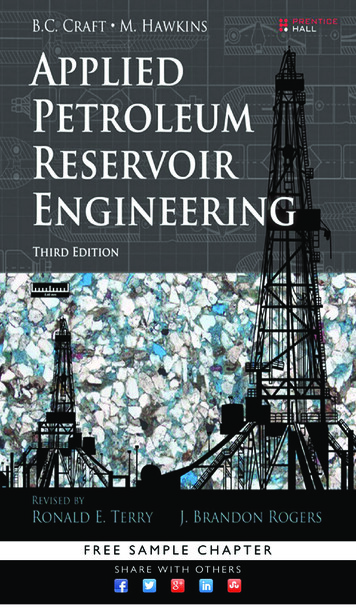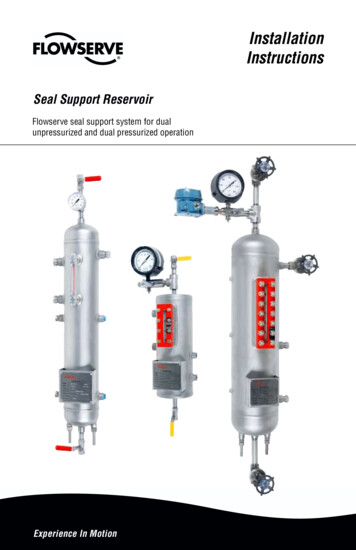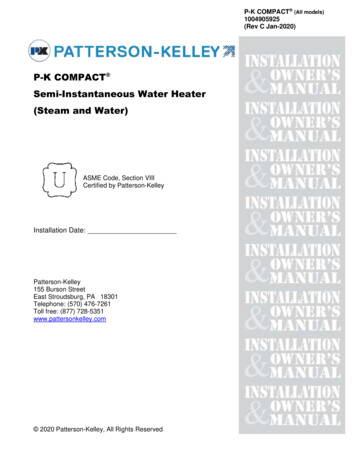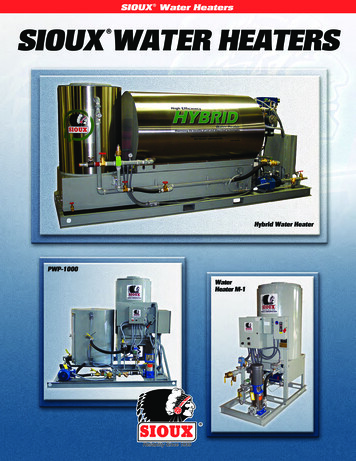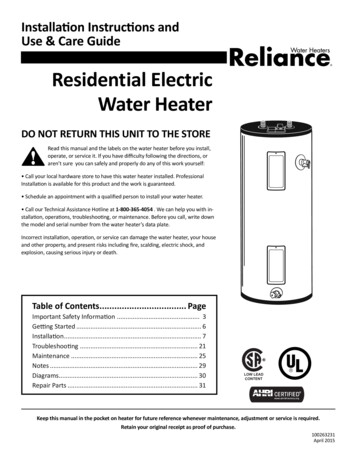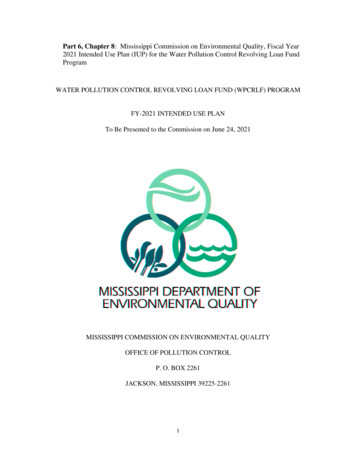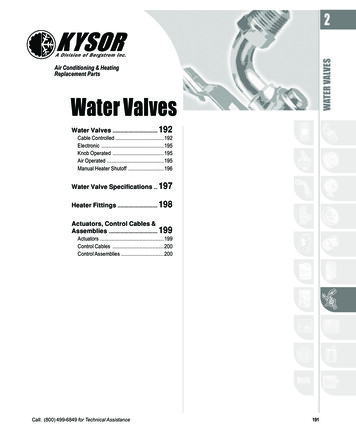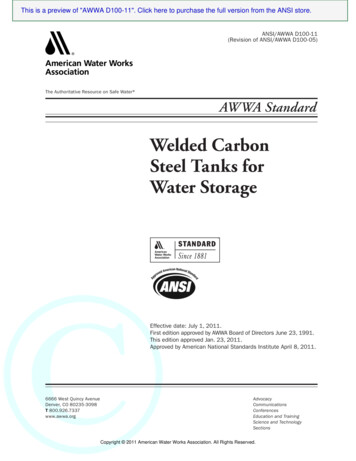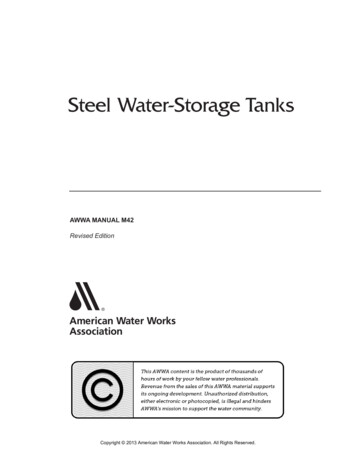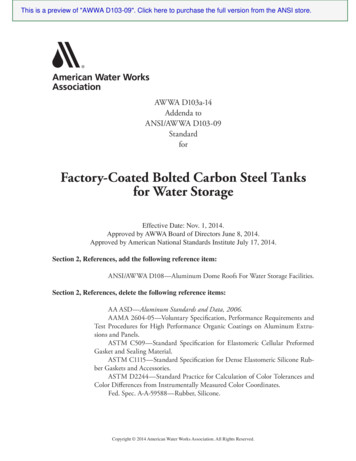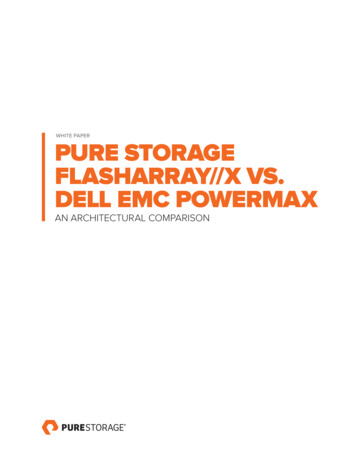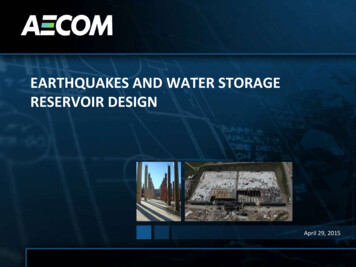
Transcription
EARTHQUAKES AND WATER STORAGERESERVOIR DESIGNApril 29, 2015
AGENDABackground - Seismic SloshingCodes and Load DevelopmentImplication to a ProjectImpact of Shape on Seismic LoadsFoundation AlternativesEarthquakes and Water Storage Reservoir Design
BACKGROUNDEarthquakeimpact onstored water?April 04, 2010,Baja MexicoM7.2Depth 10KmEarthquakes and Water Storage Reservoir Design
BACKGROUNDTime Lapse 25sShort periodshakingLocal wavesonlyEarthquakes and Water Storage Reservoir Design
BACKGROUNDTime Lapse 29sOscillation 0Wave height 1 ftEarthquakes and Water Storage Reservoir Design
BACKGROUNDTime Lapse 32 secOscillation 1 3 secWave height 1 ftEarthquakes and Water Storage Reservoir Design
BACKGROUNDTime Lapse 38 secOscillation 2 6 secWave height 2-3 ftEarthquakes and Water Storage Reservoir Design
BACKGROUNDTime Lapse 42 secOscillation 3 4 secWave height 3-4 ftEarthquakes and Water Storage Reservoir Design
BACKGROUNDTime Lapse 46sOscillation 4 3 secWave height 3-4 ftEarthquakes and Water Storage Reservoir Design
LOAD DEVELOPMENTModel Structure Codes: Washington State Building Code (SBCC) Oregon Structural Specialty Code (OSSC) International Building CodeLoad Development: ASCE7 – Minimum Design Loads for Buildings andOther Structures Defers to tank specific codes with modificationsAll ConcreteStressedConcreteSteelOtherACI 350.3AWWA D110,D115AWWA D100,D103API 650Earthquakes and Water Storage Reservoir Design
SEISMIC SLOSHING LOADSACI 350.3, AWWA and APIpublications all generallyrely on G.W. Housnermethodology for sloshing(hydrodynamic) loadsHousner 1963methodology adopted inUSA, NZ, Japan, India,othersEarthquakes and Water Storage Reservoir Design
LOAD DEVELOPMENTconvective (sloshing)water portionEarthquakeimpulsive (rigid)water tank portionEarthquakes and Water Storage Reservoir Design
LOAD DEVELOPMENTEarthquakes and Water Storage Reservoir Design
LOAD NAMICLeadingWallEarthquakes and Water Storage Reservoir Design
TYPICAL PROJECTTHE GOAL:Seismically resilient systemSEISMIC DILEMA?If funding is limited and seismic loads add to the totaldesign load, do you have to build a smaller Reservoir?THE CHALLENGE:Utilize a design approach that minimizes seismic loadsEarthquakes and Water Storage Reservoir Design
SEISMIC DESIGN PARAMETERS WE CANCONTROLIntensity of ground shaking, acceleration– Site specific history, but low rate of returnReservoir layout (buried, above grade, plandimensions, depth)– What impact does reservoir shape have on seismic sloshingloadsSite selection and geotechnical conditions– How do different foundation types resist seismic sloshingand inertia loadsEarthquakes and Water Storage Reservoir Design
ABOVE GROUND vs BELOW GROUNDBuried (getting there)Above GroundEarthquakes and Water Storage Reservoir Design
ABOVE GROUND vs BELOW GROUNDPlan length (L) 100-ftWater depth (HL) 30-ftL 100-ftEarthquakePlan width (B) 100-ftSds 0.73Ie 1.50Ri 2.0 (above)B 100-ftPlan LayoutRi 3.0 (below)– Response modificationcoefficientEarthquakes and Water Storage Reservoir Design
ABOVE GROUND vs BELOW GROUNDObservation:Buried reservoir seismic for 40% lessEarthquakes and Water Storage Reservoir Design
PLAN DIMENSIONS (L & W)HL 30-ftObservation:In order to get a reduction in load, impractical reservoirsize is requiredEarthquakes and Water Storage Reservoir Design
DEPTH (HL)180%80%0%L 100-ftObservation:Depth plays a significant role in seismic loadConsider larger footprint, shallower depthEarthquakes and Water Storage Reservoir Design
FOUNDATION SYSTEMSSite geology– Quality of below ground soils– Stability, landslide, groundwaterSensitivity to ground movement / settlement– Water tightnessTwo common foundation systems– Slab on grade, mat foundation– Deep foundations (piers, piles)Earthquakes and Water Storage Reservoir Design
MAT FOUNDATIONVertical loads to soil via contact area of matHorizontal loads to soil via friction over area of matEarthquakes and Water Storage Reservoir Design
MAT FOUNDATION – Sample Reservoir8.0MG175ft x 200ft38-ft deepBury depth variedfrom full to halfEarthquakes and Water Storage Reservoir Design
MAT FOUNDATION – Normal OperationWaterObservation:Mat foundation effective, max loads at perimeter wallsEarthquakes and Water Storage Reservoir Design
MAT FOUNDATION – SeismicEQWaterEarthquakeObservation:Mat foundation effective limiting movementCareful attention to perimeter wall loadsEarthquakes and Water Storage Reservoir Design
DEEP (PIER) FOUNDATIONVertical load supportedby end bearing/skinfrictionHorizontal loadssupported by pierdeflecting sideways andbearing on soilEarthquakes and Water Storage Reservoir Design
DEEP / PIER FOUNDATION – Sample Reservoir12.0MG550ft x 180ftWater depth varies24-ft to 46-ftFully buriedEarthquakes and Water Storage Reservoir Design
DEEP/PIER FOUNDATIONWaterStatic loading conditionsBottom slab spans between individual piersMinimal pier deflection at perimeter wallsEarthquakes and Water Storage Reservoir Design
DEEP/PIER FOUNDATIONHw 24ftHw 46ftEarthquakes and Water Storage Reservoir Design
DEEP/PIER FOUNDATION100-ft piers insoil30-ft piers inbedrockEarthquakeSeismic loading conditionsHorizontal seismic loads resisted by piersDeflection 5x larger at one endEarthquakes and Water Storage Reservoir Design
DEEP/PIER FOUNDATIONEQWaterEarthquakeSeismic loads deflect structure laterallyPiers deflect, compress soil and provide restraint butonly after horizontal deflectionEarthquakes and Water Storage Reservoir Design
CONCLUSIONSSeismic loads add to other design loadsIncreased loads can higher construction costSelect layout and design parameters to minimize seismiceffect––––Buried vs above groundPlan dimensionsDepthInvestigate alternative sites, and site geology carefullyEarthquakes and Water Storage Reservoir Design
QUESTIONS?Thank YouEarthquakes and Water Storage Reservoir Design
ACI 350.3 AWWA D110, D115 AWWA D100, D103 API 650 . SEISMIC SLOSHING LOADS ACI 350.3, AWWA and API publications all generally rely on G.W. Housner methodology for sloshing (hydrodynamic) loads Housner 1963 methodology adopted in USA, NZ, Japan, India, others Earthquakes and Water Storage Reservoir Design . LOAD DEVELOPMENT Earthquakes and Water Storage
